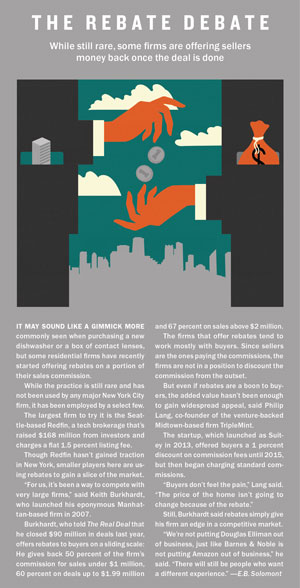Trending
Commission competition ramps up
As prices rise and sellers lose ground, 5 percent — or even 4 — becomes a new norm, shaking up the brokerage world

When Upper East Side socialite Shafi Roepers decided to relist her co-op at the exclusive 4 East 66th Street this spring, she called power broker Serena Boardman. The Sotheby’s International Realty agent came close to selling the floor-through apartment last year, but the deal fell apart at the 11th hour.
This time, however, there’s a catch.
While the property is being listed for the same $65 million, the commission for the buyer’s broker has been dropped to 1.5 percent from the typical 3 percent. The move — which comes despite the fact that it didn’t sell last time around — speaks to the fact that Manhattan agents, particularly those who work in the high-end luxury market, have been increasingly willing to accept less in today’s challenging market.
“Over $15 million, I haven’t seen 6 percent,” said Jed Garfield, president of the brokerage Leslie J. Garfield, referring to the full commission shared equally between agents for buyers and sellers. “The old 6 percent on a sale is absolutely a thing of the past.”
Kirk Henckels, director of private brokerage at Stribling & Associates, said that while the market use to be “solidly 6 percent,” now “we’re solidly 5 percent.” And in some cases, 4 percent is in play.
Henckels attributed the drop to the fact that prices have skyrocketed in recent years.
“It’s one thing to have a $20 million listing, but suddenly you have $30, $40, $50 and $100 million listings and it all has to be reexamined,” he said.
While some agents are using their fee as a bargaining chip as they jockey for listings, the commission decreases are also being pushed by some sellers, who are looking to save money in a softening market, said Douglas Elliman’s Frances Katzen.
“[Some sellers] are like, ‘Tough shit, I’m not paying more than 5 percent on a co-broke deal or 4 percent on a direct deal,’” she said, referring to a transaction where one broker represents both sides.
But, she said, smart sellers will pony up 6 percent to incentivize agents to get their unit sold.
Brown Harris Stevens President Hall Willkie said his firm can “get 6 percent on a $10 million listing, but we’re willing to do it for 5 percent.” Four percent, he said, is the norm above $20 million.
Meanwhile, some agents told The Real Deal that there’s an increasing number of brokers in today’s market who are also offering commission discounts for another, less scrupulous reason: to undercut their rivals.
“There are always desperate people who do desperate things” to win listings, said Compass President Leonard Steinberg.
Too much money
In some ways, residential commissions are starting to mirror commissions in the commercial sector, where the percentage paid to a broker drops as the price goes up. A broker selling a $1 billion building, for example, is more likely to take home 0.5 percent versus 2 or 3 percent for a building under $50 million.
The recalibration comes as residential prices are rising, even as the market softens.
Last year, the median sale price for a luxury Manhattan property — defined as the top 10 percent of the market — was $6.6 million, a nearly 77 percent jump from 2007, according to appraisal firm Miller Samuel. But the number of sales dropped 15 percent to 1,146 during the same time.
Henckels said commissions have proven to be effective to keep negotiations moving as sales have slowed.
“If I take a 5 percent listing, it gives me enough money to use it as a tool on [the seller’s] behalf,” he said. “You need tools to try to pull parties together. One of those tools is the fact that there’s enough commission there to cut it.”
Veteran brokers said that in neighborhoods like the Upper East Side — particularly in co-op buildings where sales have lagged behind new condos — 4 percent is now commonplace.
While there’s no definitive data to bear that out, current listings do show a significant amount of lower-than-typical commissions in the area.
Of 114 properties on the Upper East Side that were asking $15 million or more on June 13, sellers were offering 2 percent commissions to the buyer’s agent on 15 percent of listings and 2.5 percent on 41 percent of listings, according to an analysis by TRD of properties listed on On-Line Residential.
Commissions for sell-side agents are not listed in OLR, making it difficult to draw conclusions about whether they are also taking a financial hit.
For example, while Roepers dropped the buyer’s broker commission to 1.5 percent, it’s unclear whether Boardman’s commission is also being reduced.
The same is true at a $70 million co-op at 795 Fifth Avenue. According to OLR, the buyer’s broker is being offered 1.5 percent, though it’s unclear whether the listing broker, BHS’s John Burger, is seeing a commission reduction, too.
“On a gross basis, it’s just a lot of money,” said Garfield. “Sellers do quick back-of-the-book calculations, and for a $20 million deal, they say, ‘I’m not paying $1.2 million in brokerage fees.’”
Platinum Properties CEO Khashy Eyn said he originally negotiated a 5 percent commission on a $22.5 million unit at One57. But when the lender moved to foreclose on the property in June, he cut it to 4 percent.
“The owner was in trouble. He was losing money on it,” Eyn said. “We have morals.”
Stefani Berkin, president of Rutenberg NYC, said it makes sense to take a 5 percent commission if it’s the only way to get an exclusive, especially because the deal could lead to future business.
“This is a relationship-driven industry,” she said. “I believe if you do well by one, they’ll use you again and again.”
While 6 percent fees are common in the under-$1 million range, agents say discounts can pay off at lower price points, too, particularly if the client is an investor looking to buy and sell multiple units.
Keller Williams Tribeca agent Annette Holmgren, who is currently marketing a loft in the Lincoln Square area for an investor, said the full commission on her $895,000 listing is 4.5 percent. The discount, she said, is worth it because the client buys and flips multiple units a year.
“We will never offer less than 2.5 percent to the buyer’s agent, because we need to pay them well to help us resell the unit,” she said. “However, I happily take less to ensure my client has the highest possible return on his investment and that we continue our relationship.”
Six or bust
Despite the shifting landscape, many big firms like Douglas Elliman, the Corcoran Group and others expect their agents to stick to 6 percent. But ask any agent privately and they’ll say everything is negotiable — to a degree.
One longtime broker put it this way: “I’m basically willing to match anything reasonable. But we’re not a discount house … if you come to me at 3 percent [for both sides of the deal], no, I’m not interested.”
Others say discounting is dangerous.
“I don’t believe in predatory [commission] pricing,” said Stuart Siegel, CEO of the New York operation at Engels & Völkers. “We know we offer a value proposition, which justifies a 6 percent fee.”
 Another brokerage chief warned that brokers run the risk of being perceived as obsolete if they discount. While agents used to be gatekeepers of information, their central role in today’s market — where listing information and comparable-sales data are accessible to anyone with a web browser — is to provide context, analysis and service to clients.
Another brokerage chief warned that brokers run the risk of being perceived as obsolete if they discount. While agents used to be gatekeepers of information, their central role in today’s market — where listing information and comparable-sales data are accessible to anyone with a web browser — is to provide context, analysis and service to clients.
“The more you discount, the more you make yourself worthless,” the brokerage head said.
The one key thing brokers can’t do, of course, is collude to set fees, which is illegal. And the Real Estate Board of New York’s universal brokerage agreement states that agents cannot “fix, control, recommend, suggest or maintain” commission rates.
Brokers did not suggest that rivals were flouting those guidelines.
They did, however, say that in today’s hypercompetitive market, the listing agent is often paying steeply to market a luxury property — and expensive marketing campaigns can drag on for months if the property lingers. While firms pick up a portion of an agent’s marketing costs, brokers often reach into their own pocket to make up the difference.
“On some listings, I’ve spent well over $100,000 on marketing,” Compass’s Steinberg said. “On average, I spend $20,000 a month on just one mailing.”
Steinberg and others agents warned that slashing commissions at a time when inventory is up could haunt sellers — and listing brokers. Faced with two comparable apartments — one paying a full commission and the other a reduced one — the buyer’s broker may lean toward the former.
“It’s not a good time for a seller to be nickel-and-diming on 1 percent of the listing fee,” said Andrew Heiberger, CEO of Town Residential. “You don’t want to disincentivize brokers from looking at your property because they’ll make less money,” he said.
To that end, developers with slow-selling products have actually gone in the other direction, embracing incentives and commission increases.
For example, Zeckendorf Development is currently offering a higher-than-normal 4 percent commission to buyers’ brokers at 50 United Nations Plaza. World Wide Group and Rose Associates are doing the same at 252 East 57th Street. In addition, developers RFR Realty and China Vanke Group are offering 3.5 percent to buyers’ brokers at 100 East 53rd Street.
And some resale sellers are going against the grain and doing the same — boosting the agent’s fee by 0.5 or 1 percent.
Elliman’s Richard Steinberg said that at a co-op at 525 Park Avenue, his seller was initially planning to go with a 5 percent broker fee, but offered any buyer’s broker who produced a contract within 60 days an extra 1 percent.
The strategy worked. The unit — which was last listed for $7.9 million — went into contract in mid-June after six months on the market.
“What you’re creating is a sense of urgency to bring the buyer in for a limited amount of time,” said Steinberg, who will get 2.5 percent while the buyer’s broker will collect 3.5 percent.
He said he’s now trying to convince another seller to bump up the buyer’s broker commission at 20 East 65th Street.
“Somehow it’s more tolerable to hear, why don’t we give the buyer’s broker another percent,” Steinberg said. “Rather than think about reducing the price by $1 million, he’s giving up another $150,000 in the hopes of bringing $500,000 more.”





